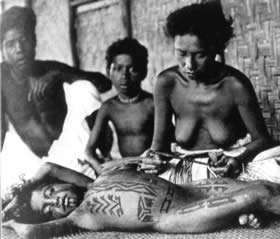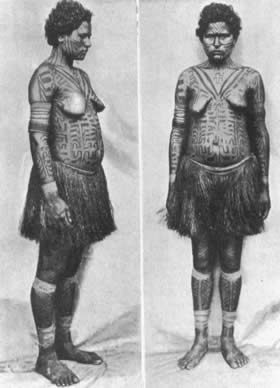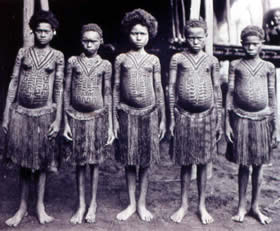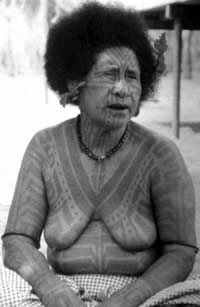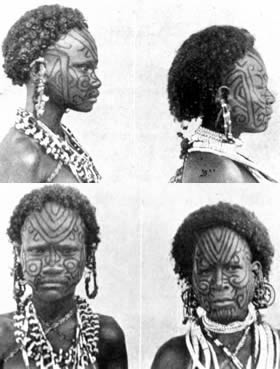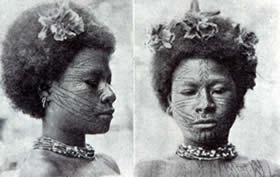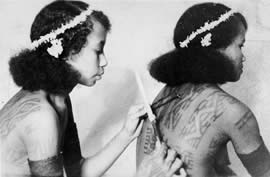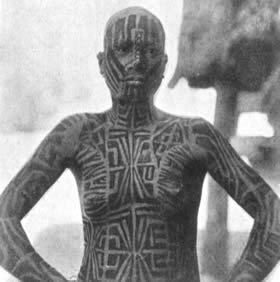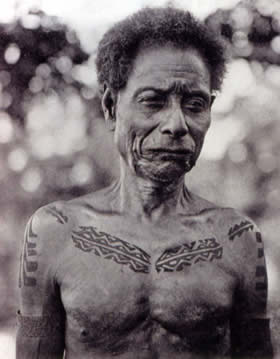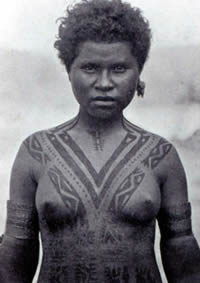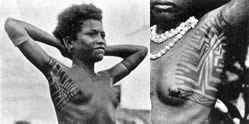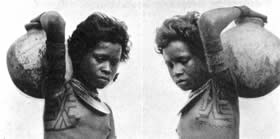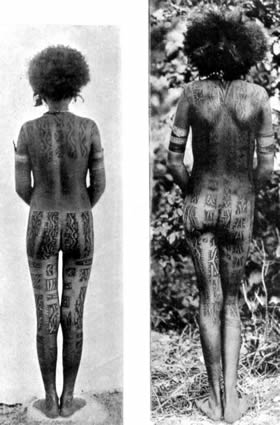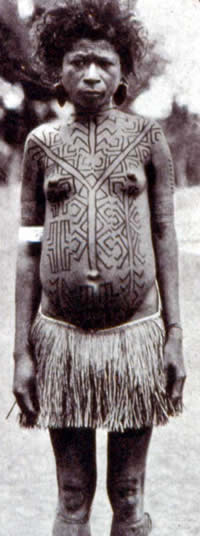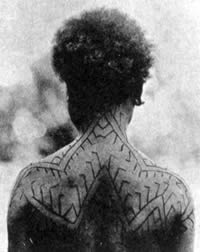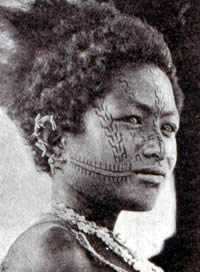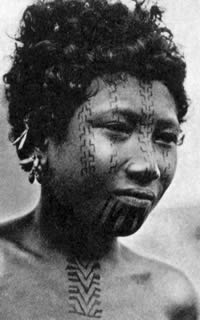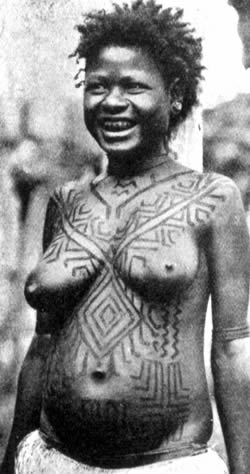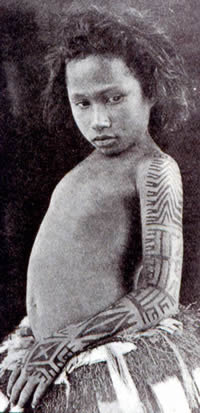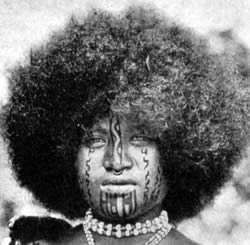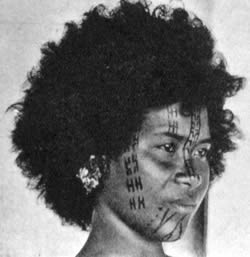
| Celeb Tattoos | Facts & Stats | Designs & Symbols | History | Culture | Links | Tattoo Galleries | Contact | ||||||
THE FORGOTTEN CODE: TRIBAL TATTOOS OF PAPUA NEW GUINEA
© 2005 by Lars Krutak As far back as the old men and women can remember, tattooing has been a tribal custom of the coastal peoples of Papua New Guinea. Among the Motu, Waima, Aroma, Hula, Mekeo, Mailu and other related southwestern groups, women were heavily tattooed from head to toe, while men displayed chest markings related to their exploits in the headhunt. By World War II, however, tattooing traditions largely disappeared in these areas and today only the Maisin and a few neighboring peoples of Collingwood Bay in southeastern Papua remain as the last coastal people to continue tattooing itself. Tattoos were generally inked upon women in a fixed order among all coastal Papuans. First, girls between five and seven years of age were tattooed on the backs of hands to the elbows and from the elbows to the shoulders. Girls between seven and eight were tattooed on the face and lower abdomen, the vulva and up to the navel, then the waist down to the knees and the outside of the thighs. At ten, the armpits and areas extending to the nipples were tattooed with the throat done shortly thereafter. When puberty approached, the back from the shoulders down, then the buttocks, back of the thighs and legs were marked. When ready for marriage, V-shaped designs from the neck down to the navel were tattooed. Sometimes, special tattoos could be added if the father, brother, or close relative of the girl killed another man, or if they showed prowess in fishing or trading expeditions. All of these markings were ritualistic, and in some cases erotic. If a girl did not have them, she was not acceptable for marriage. Many of the tattoo motifs were passed down through the family - from mother to daughter, and sometimes from father to son. Unfortunately, ethnographic information on most tattoo motifs has been lost - modernity and missionization are largely to blame. For example, tattoos related to the headhunt have been largely forgotten, since killing was outlawed in 1888 when Great Britain annexed Papua. Tattoos associated with the Hula and Motu trading voyages (lakatois) are also no longer seen; motorboats have replaced the traditional sailing vessels and these once formidable expeditions are no longer dangerous. Moreover, missionaries began discouraging initiation ceremonies in the early 20th century, and today tattoos are no longer needed for marriage. Thus, the meaning of Papuan tattoos is fading and gradually being forgotten. Tattooing Kits and the Women Who Used ThemTypical tattooing kits were fairly simple and the technique employed to apply the tattoos was a form of hand-tapping. Among the Motu, the wooden "hammer" was called iboki and the needle-like gini was a lemon branch twig with a thorn projecting out at one end. The Motu first painted the desired tattoo motif on the skin and allowed it to dry. With the gini held in the left hand, with the point of the thorn almost touching the skin, and the iboki held in the right hand by the small end, the gini was tapped with enough force to cause the thorn to pierce the skin. For finishing the tattoo, the gini may have had three or four thorns tied together for filling. Usually, tattoo pigment came from the charred remains of the candlenut. Candlenut (Aleurites moluccana) was also utilized as pigment in Hawaii (kukui) and other Pacific islands in Polynesia. Interestingly, I have found that the leaves and sap of the candlenut tree were used throughout Polynesia, the Philippines, China and Indonesia in the treatment of arthritic joints or as a healing application for chapped lips, cold sores and sunburn. Even in Papua, the Sinaugolo tribe specifically utilized several types of "medicinal" tattoos to treat rheumatoid arthritis. These marks were usually grouped around aching joints on the back, neck, shoulders, and forehead. Triangular motifs seen under the left breast of a Sinaugolo man in the 1880s appeared to one explorer as "hav[ing] been tattooed for palpitations or uneasy sensations in the region of the heart." Traditionally, tattoo artists were almost always female and different women were employed for tattooing specific parts of the body. Among the Mailu, facial tattoo artists seem to have been paid more, as this work was the most painful and dangerous. Around 1900, a typical payment for facial work included two strings (pairs) of armshells, quantities of cockatoo and parrot feathers and a string bag, whereas other parts of the body may have only brought small payments of cooked food.
Motifs
The tattooed tribes of coastal Papua seemed to prefer abstract motifs of natural subjects, and those of falling objects (stars), flying birds, especially predatory birds (Frigate bird, hawk) or other creatures associated with movement and predatory habits (like centipedes, serpents, and crocodiles) were quite common. But some of these animals were tattooed onto living skin for other reasons; they were able to straddle diurnal and nocturnal lifestyles, thus mastering the worlds of both light and darkness. For the Papuans, this otherworldly existence was perceived in abstract reality as "life" on the supernatural plane of the living and the dead. And it is no surprise that most, if not all, of these animals were believed to repel evil spirits and were tabooed from being eaten altogether. Frigate birds, however, seem to have ranked highest on the tattoo motif map. Characterized in folk belief as a rapacious, ravenous, and voracious seagoing predator, frigates were widely associated with Papuan headhunting mysticism, somehow lending power to the wearer, or even to the family of the tattooed, acting as a sort of spiritual "assistant." This belief was shared, since many other headhunting groups living in Polynesia, Melanesia, and Indonesia tattooed the emblem (Note: frigate tattoo motifs extended as far as the headhunters of Easter Island). Sometimes tattoo motifs took the form of harmless birds like the great-beaked hornbill or bina among the Papuan Hula and Motu. Among the Iban of Borneo, the hornbill was tattooed on headhunter's chests, because it was thought to provide protection against the intrusion of evil spirits. It was associated with the Upperworld and it was a sacred omen bird. This association between man and bird, was expressed in tattoo as well as in mimic bird dances, songs and the wearing of feathers as a symbolic ornament. Among the Papuan Hula of the 1880s, warriors who had taken human life wore white cockatoo feathers in their hair, the mandibles of the hornbill on their foreheads and other plumes as headdresses, not to mention tattoos on the legs and chest. As noted before, even sons, daughters and the wives of those men who had taken heads were entitled to tattoos worn on their skins. But Papuan men who headhunted were considered to be unclean until they had undertaken specific ceremonies to purify themselves. Usually, once they had returned from an expedition, headhunters were secluded from the community for a period of time and then reincorporated into the village after, as one elder said, "having been assured of scaring the ghost of the dead away." One traveler to the Hula noted in 1883 that, "Even the dead ancestors of tribes are on the watch to deal out sickness or death, to anyone who may displease them, and the natives are most particular to do nothing that should raise their ire." The Forgotten CodeWomen's bodies along the Papuan coast no longer speak their complex and ritual language. And as the skin continues to heave in the moist jungle heat, it no longer glistens with elaborately patterned tattoos - which at one time covered lithe and supple bodies. Today, coastal Papuan tattoo is an abstract art form barely recognizable and largely forgotten. Yet despite these shortcomings, each indelible symbol allows us to dimly discern those concepts and ideologies of a cultural code that once served to represent the complex of life experience in the natural and spiritual worlds of the tribal headhunters of Papua New Guinea. |
||||||
|
Other tattoo articles by Lars Krutak
© VanishingTattoo.com |
||||||
| Celeb Tattoos | Facts & Stats | Designs & Symbols | History | Culture | Links | Tattoo Galleries | Contact |
